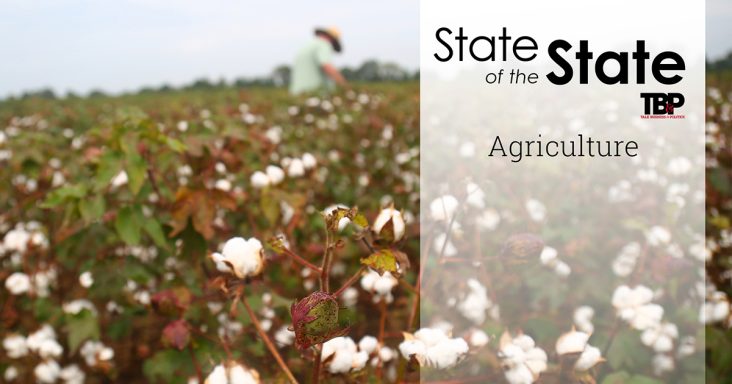State of the State Mid-Year 2024: Arkansas farmers facing ‘pretty rough’ conditions
by September 11, 2024 12:26 pm 301 views

Financial viability for some farmers is becoming an increasing concern for agriculture stakeholders and public officials as the harvest season draws near, according to Arkansas Secretary of Agriculture Wes Ward.
In recent weeks he’s been receiving more phone calls and had meetings about a myriad of factors that have been chipping away at farm profitability, he said.
Inflation, higher input costs, freight costs, higher interest rates, commodity price gyrations and low water levels on the Mississippi River are all reducing farm profit margins, he said. Some of the stakeholders he’s been in talks with include financial institutions, and the outlook is grim.
“It’s looking pretty rough. … It’ll be interesting to see what it looks like in 90 days when producers start planning for 2025,” Ward said.
Some of the factors plaguing farmers, such as input cost and commodity price fluctuations, are factors every year, but one that is becoming more consistent is the lack of water in the Mississippi River. For the third straight year, the water level at Memphis will be in negative territory as the harvest begins.
Last year, the river at Memphis dropped to an all-time low of minus 11.5 feet in October. It topped the previous record of minus 10.81 feet set in 2022. Despite consistent rain throughout much of the region, the river was projected to be at minus 3.2 feet by the end of August, according to the National Oceanic and Atmospheric Administration’s National Water Prediction Service.
The mid-south hasn’t had drought-like conditions, but a lack of snow last winter in the upper Midwest and lower rain levels in the spring and summer have led to lower water levels with many tributaries in the river’s upper system.
Barge traffic stalled on the river during harvest last year, leading some farmers to dump their crops on the sides of the river or on islands created when the water level was low.
The Mississippi River is a vital artery for grain transportation. According to the U.S. Department of Agriculture’s (USDA) Federal Grain Inspection Services, 57% of U.S. soybean exports and 47% of corn exports have been shipped out of New Orleans in the current marketing year. The Mississippi River is also important for the movement of fertilizer. Industry sources estimate about 33% of urea and diammonium phosphate moves up the Mississippi River from the Gulf of Mexico.
Higher freight rates and weaker basis loom for farmers as they begin to pull crops from their fields, said Scott Stiles, extension economics program associate for the University of Arkansas System Division of Agriculture. Basis is the difference between the cash price and the futures price for a commodity. Stiles said since Aug. 1, corn basis has fallen up to 5 cents and soybeans up to 15 cents at some Mississippi River terminals.
Ward said a loss of basis like that can be the difference between turning a profit and struggling to break even. He said state officials are keeping a wary eye on the river as producers begin to haul crops from the fields.
On the flip side, he said the state is poised to have one of its best production cycles in years. Soybeans are projected to have a record bushel yield of 57 bushels per acre, according to the USDA. The USDA’s National Agricultural Statistics Service predicts that cotton production will rise by 21% to 1.65 million bales, which is 288,000 bales more than last year. Yields are expected to be 57 pounds per acre lower than last year, forecast at 1,238 pounds of lint. Harvested acres were expected to be up 135,000 acres from last year to 640,000.
Rice production is forecast at 109 million hundredweight, up 2% from last year. The yield for all rice is forecast at 7,600 pounds per acre, up 50 pounds from last year. The forecast for harvested acres rose 30,000 acres to 1.43 million acres.
Corn production is forecast at 90.2 million bushels, down 41% from last year. However, yield is expected to average 186 bushels per acre, up three bushels from last year. NASS revised the planted acres downward by 120,000 acres to 500,000. Harvested acres were also expected to drop from 600,000 to 485,000.
“We’re having a great production year,” Ward said. “Farmers have taken advantage of opportunities and tackled numerous challenges. There’s a sense of optimism from a production standpoint.”
The state did lose another cotton gin in 2023, according to the USDA. The state had 28 in operation that year, one less than in 2022. Ward, a northeast Arkansas native, said he doesn’t know why the gin was shuttered, but he suspects it was a business decision.
The number of gins in Arkansas has dropped from 138 in 1991 to 28 in 2023. There are 14 counties with gins, most of them near the Mississippi River. One is closer to central Arkansas in White County. Ward said he and many who were born and live in the region are saddened when a gin closes, not just from a business perspective but a cultural one as well.
“You hate to see those things happen. You love to see the cotton fields and cotton gins in northeast Arkansas,” he added.
